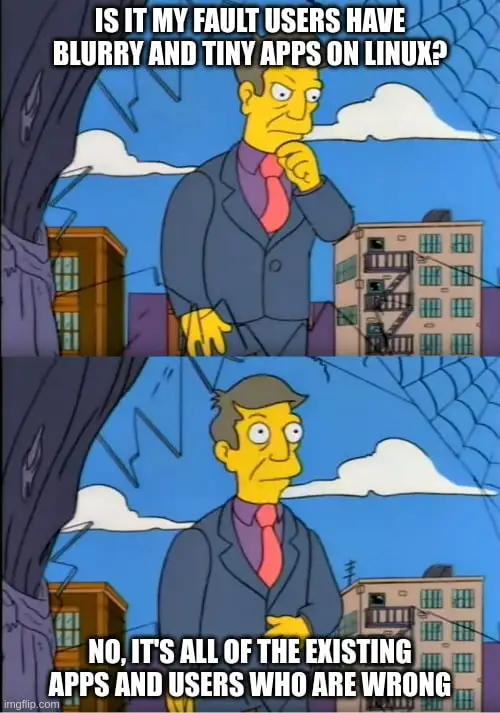

For sure use Tailscale for VPN. They have apps for iPhone, Android, macOS, and Linux, so setting up your own personal network will be easy. Hosting on the real internet is definitely advanced and not always necessary.


For sure use Tailscale for VPN. They have apps for iPhone, Android, macOS, and Linux, so setting up your own personal network will be easy. Hosting on the real internet is definitely advanced and not always necessary.
3,157,200,000J
Or just 3.1572GJ.
Which apparently is how this Canadian natural gas company bills its customers: https://www.fortisbc.com/about-us/facilities-operations-and-energy-information/how-gas-is-measured
Check the documentation can be pretty useless a lot of times. The docs aren’t always great or they’re huge and I have a specific question. Often times I do check them, but they’re incomplete or unclear. Or the docs change or the links die.
Just answer the question anyway and then say where you found it.
Not sure if everyone knows this, but: if you don’t want to answer the question—you don’t have to post a reply! Crazy idea, I know.


That link kinda showcases exactly my point… It’s pretty useless to me. I know how to install the app. I don’t know what the daily workflow looks like.
Compare that to the tutorials YNAB has on YouTube. Those talk more about how to use the app to budget.
Anyway, it’s fine. I understand I’m not the target audience for Actual. It seems like it’s for people who already have prior experience with finance apps.


Do you just use a limit set of YNAB features? It seems like Actual only has a tiny fraction of the features YNAB has. For example, it’s currently missing category targets.


As a note for people new to budgeting apps, YNAB has a toooonnn of tutorials and videos about how to create a budget and what the end-to-end workflow looks like in their apps.


Is there some tutorial you’d recommend to get started? I didn’t find the docs or demo helpful and a lot of videos seem to be focused on background or setup. I can install the app fine, but like how does one actually use this?
I’ve never used budgeting apps. I’d like to learn more about them and why they’re useful. My current budgeting is: positive balance=good; negative balance=bad


Hell yeah! Sign me up!


It’s all right otherwise. Not phenomenal, but not crap. The specs you can get with other laptops. The hardware feel isn’t as good as a Dell XPS or an X1 Carbon. The expansion card stuff is kinda cool, but other laptops have ports too. I’ve never swapped out the cards.
The main reason I bought this laptop is repairability. If that’s not your main priority, then I probably wouldn’t recommend this laptop.
If you want to use this laptop with Linux and not spend time fixing hardware compatibility issues, then I definitely would not recommend this laptop. Definitely get a Dell XPS for a Linux laptop that Just Works.


Agreed! Not saying it’s not a software issue. Of course the software is broken. Of course I wish it was updated.
But, Framework seeing the landscape and picking hardware with known issues is a bad choice. They could offer lower DPI and eliminate entire pages of workarounds and half fixes.
Yes, high DPI should work, but it doesn’t everywhere. That’s just the reality, I wish it wasn’t.


Blurry and tiny apps come from Framework’s poor choice of display. Other laptops don’t have this problem.
Yes, I’m aware of software-side issues, but it’s still their fault for seeing the software issues and then picking a broken display anyway.



HiDPI has to be supported by all toolkits, desktops, and applications at this point. There are no excuses.
I mean… yeah, I agree. Would you mind sending that email to the millions of devs around the world? Not sure if they’re aware of this.
I just want to be able to read my screen. 😭


If it meant I could actually see my apps because they’re not blurry and not tiny. Then hell yeah! Luckily, it’s not a choice between all the DPI and none of the DPI.
It’s possible.
What’s a webradio? https://www.funkwhale.audio/ seems like a music app? Hmm… Seems interesting.


I found a related thread to this on Hacker News. It was interesting to read: https://news.ycombinator.com/item?id=19365968


I was wondering the same thing. It seems more proper to run a separate government Mastodon server. Otherwise, they’re showing preferential treatment to one company.
Although… they probably can’t handle self hosting? But really? The all mighty US can’t self host a server?


For Discord like communities, I’d also suggest using Element as the Matrix client. It’s pretty similar to Discord. Also, you’ll need support for “spaces”, which are like Discord servers. Rooms = channels
Literally me with my Framework laptop, trying to get hidpi to work. I either get tiny text, blurry text, tiny icons, but fine text, or some other weird combination of shit. Luckily, gnome-terminal does work. So as long as I never use any GUI apps, then hidpi “works” on the Framework. 🥴👍
No, I will not switch to Fedora. Yes, I’ve tried it. No, I’m not a fan of “fixing” hidpi by avoiding scaling, everything is tiny. Yes, I’ve also tried the new Framework display at 2x scaling, no I didn’t like it.
The real solution for me is to avoid this class of problems altogether by going back to a regular dpi screen, where everything was legible, clear, and I could use whatever damn GUI apps I wanted. I’m moving back to an X11 Carbon (rip Dell XPS) next chance I get.